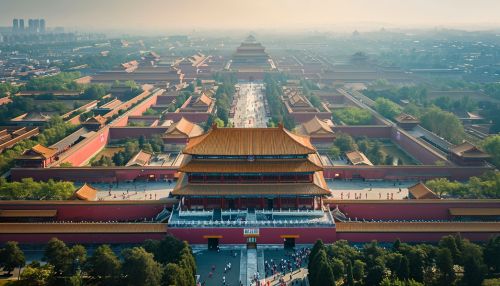Ming dynasty
Origins and Rise
The Ming dynasty was a Chinese dynasty that ruled from 1368 to 1644, following the collapse of the Mongol-led Yuan dynasty. The Ming, described as "one of the greatest eras of orderly government and social stability in human history," was the last dynasty in China ruled by ethnic Han Chinese. Although the primary capital of Beijing fell in 1644 to a rebellion led by Li Zicheng (who established the short-lived Shun dynasty), remnants of the Ming throne and regime, known as the Southern Ming, survived until 1662.


Government and Administration
The Ming dynasty was characterized by effective governance and a comprehensive system of laws. The emperor was at the center of Ming government, but his power was often limited. This was due to a system of checks and balances, which was achieved through the establishment of relatively independent institutions—the Censorate, the Hanlin Academy, and the Grand Secretariat. The emperor's role was both as the head of the bureaucracy and the spiritual leader of society.
Economy
The economic system of the Ming dynasty was one of the most prosperous in the world at the time. The economy was marked by a rapid increase in population, urbanization, unprecedented growth in industry and trade, and the increasing use of paper money. The Ming economy was stimulated by maritime trade, which was conducted through the tribute system. The government also encouraged agriculture, particularly the cultivation of rice in the south and wheat in the north.
Culture and Society
The Ming period is often considered one of the three golden ages of China, alongside the Tang and Song dynasties. During this time, there was an incredible proliferation of culture and knowledge. In literature, a form of vernacular literature based on Mandarin dialects became popular. In philosophy, the most notable figures were Wang Yangming and his followers, who proposed a system of moral philosophy that merged the concepts of identity and knowledge. In visual arts, the Ming dynasty is known for its painting, porcelain production, and architecture.
Decline and Fall
The fall of the Ming dynasty was a period of chaos and political instability. The dynasty was weakened by factionalism, corruption, and an increasing gap between the rich and the poor. The dynasty fell in 1644, when the capital, Beijing, was captured by a coalition of rebel forces led by Li Zicheng. The last Ming emperor, the Chongzhen Emperor, committed suicide when the city fell, marking the official end of the dynasty.
Legacy
The Ming dynasty left a significant legacy, both in China and across the world. Its influence can be seen in various aspects of Chinese culture, including literature, philosophy, art, and architecture. The dynasty's policies and systems of government have been studied by scholars for centuries and continue to influence political thought today.
